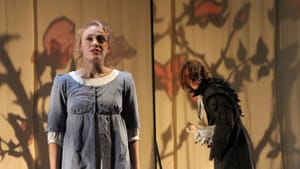Stay in the Loop
BSR publishes on a weekly schedule, with an email newsletter every Wednesday and Thursday morning. There’s no paywall, and subscribing is always free.
For love or money?
'Beauty and the Beast' at the Arden

Beauty and the Beast is one of those classic fairy tales that we think we know, but what we really know is the Disney version of a darker story. The Arden’s Children’s Theater has brought us a play that is closer to the original and yet more modern than most other versions we have seen. This beast isn’t like those on the various TV updates, each a human monster so out of the norm that he can’t fit in with society, befriended by a feisty woman who risks life and limb to keep him safe. The Arden’s Beast is a beastly yet attractive creature, played by Matteo Scammell, with hair in his eyes and an ability to leap and climb ladders, who doesn’t seem all that threatening — although being sniffed by a large hairy creature could be disconcerting in itself.
The major changes have to do with how the Beast came to be a beast, and the family of Belle (Emilie Krause), the beauty who redeems the Beast. Belle’s father, George Godwin (Brian Anthony Wilson) is a merchant who loses all his worldly possessions when his ships go down, as in the original, but in this version, the emphasis on money and success, while having a modern ring, makes everyone seem very petty. Godwin falls apart without his money and is far too willing to sacrifice his favorite daughter to the Beast to save his own life. Belle's sister Cassandra (Lauren Hooper) wants fancy dresses and treats everyone around her with contempt. Without her finery, she is miserable and intent on making everyone else suffer as well.
Wealth, not love
Thus, this version has a lot to do with wealth and status rather than love and goodness. When Godwin loses his money, Cassandra rejects her suitor Daniel Knightly (Kevin Meehan), who lied about having wealth, and the family retreats to a country house while Godwin goes off to see what he can salvage. Tired and lost and still penniless, he stumbles into the Beast’s castle, where he is served a sumptuous invisible banquet, sleeps well, and then departs, taking a rose from  the garden to fulfill Belle’s only request of him. This angers the Beast, but in return for the promise of Godwin’s daughter, the Beast lets him go free.
the garden to fulfill Belle’s only request of him. This angers the Beast, but in return for the promise of Godwin’s daughter, the Beast lets him go free.
When Belle arrives at the castle, she is warned off by the mysterious Housekeeper (E. Ashley Izard), and finds her way to the Beast, only asking to leave when she sees in a magical mirror that her father is ill. She returns home, her father is magically cured, and even some of his wealth is returned to him. Sister Cassandra sends her new suitor, a country bumpkin named Jan who courts her with a dead goose, to kill the Beast. Belle goes after him to save the Beast, stops the fight, admits her love for the Beast, and returns him to princehood with a kiss. From then on, everyone is happy and healthy and, most importantly, wealthy and ready to live happily ever after.
For Belle, this is a story about overcoming fears, so the production emphasizes a fearful environment. She’s especially afraid of spiders, and one is always lurking nearby. But when her father is in danger, timid Belle suddenly plunges forth into a hostile forest to rescue him — although he doesn’t quite seem worthy of her sacrifice.
An outline of a heroine
One of the hazards of pitting a pure heroine against well-drawn villains is that the heroine seems weak in comparison. Putting the heroine in a nightgown for much of the production just adds to her vulnerability. Innocence just isn’t as much fun as evil, and even mild malice allows an actor greater range. Poor Belle could have used a little more story to help us relate to her.
The setting, by Sebastienne Mundheim of White Box Theatre, was a magical dreamscape created out of light and shadows cast against the walls and curtains. Cast and crew carried lights in their pockets and moved cardboard ships and chairs and roses to create an ethereal environment. Mundheim truly used the magic of the theater to create, with limited furnishings, an environment that was somehow still believable.
The problem with this version as children’s theater is that it is just not that much fun. Although one strength of the Arden’s productions for children is that they don’t talk down to their young audience, this production doesn’t provide much for a young person to latch on to. In the second act there is a playful dance and a horribly out-of-tune duet — more howling than singing — that brought the audience to life, but otherwise, Belle’s world of fears and limitations and the disagreeable people around her kept the story a bit somber.
Above right: Matteo Scammell as the Beast. (Photo by Mark Garvin)
What, When, Where
Beauty and the Beast. By Charles Way. Whit MacLaughlin directed. Based on the French fairy tale written by Madame de Villeneuve and then by Madame Jeanne-Marie LePrince de Beaumont. Through February 1, 2015 at the Arden Theatre Company, 40 N. 2nd St., Philadelphia. 215-922-1122 or http://www.ardentheatre.org.
Sign up for our newsletter
All of the week's new articles, all in one place. Sign up for the free weekly BSR newsletters, and don't miss a conversation.
 Naomi Orwin
Naomi Orwin